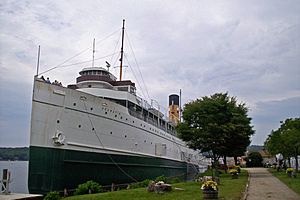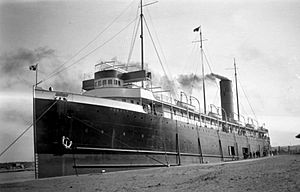SS Keewatin facts for kids

Keewatin alongside in Douglas
|
|
Quick facts for kids History |
|
|---|---|
| Name | Keewatin |
| Owner | Canadian Pacific Steamship Company |
| Port of registry | |
| Builder | Fairfield Shipbuilding and Engineering Company, Govan, Scotland |
| Launched | 6 July 1907 |
| Christened | 1907 |
| Maiden voyage | 14 September 1907 |
| In service | 7 October 1908 |
| Out of service | 29 November 1965 |
| Status | Museum ship |
| General characteristics | |
| Type | Passenger liner |
| Tonnage | 3,856 GRT |
| Length | 102.6 m (336 ft 7 in) pp |
| Beam | 13.3 m (43 ft 8 in) |
| Draught | 23 ft 7 in (7.2 m) |
| Installed power | 3,000 hp (2,200 kW) nominal |
| Propulsion |
|
| Speed | 16 knots (30 km/h; 18 mph) max |
| Capacity | 288 |
| Crew | 86 |
SS Keewatin is a passenger liner which once travelled between Port Arthur/Fort William (now Thunder Bay) on Lake Superior and Port McNicoll on Georgian Bay (Lake Huron) in Ontario, Canada. She carried passengers between these ports for the Canadian Pacific Railway's Great Lakes steamship service. Keewatin also carried packaged freight goods for the railway at these ports.
Keewatin is the largest of the remaining Edwardian era passenger steamers remaining in the world, along with Nomadic, and the lake steamer TSS Earnslaw (1913), currently still operational in New Zealand.
Description
Keewatin is a passenger liner that when built, measured 3,856 gross register tons (GRT) and 2,470 NRT. The ship has a length between perpendiculars of 102.6 metres (336 ft 7 in) and a beam of 13.3 metres (43 ft 8 in) with a draught of 7.2 metres (23 ft 7 in). The vessel was powered by four coal-fired scotch boilers, each 4.3 metres (14 ft 1 in) by 3.4 metres (11 ft), providing steam to a quadruple expansion steam engine turning one screw creating 3,000 horsepower (2,200 kW) nominal. This gave the ship a maximum speed of 16 knots (30 km/h; 18 mph) and a cruising speed of 14 knots (26 km/h; 16 mph).
The ship had 108 staterooms with berths for 288 passengers. The vessel was manned by 86 officers and crew.
Construction and career
Built by Fairfield Shipbuilding and Engineering Company in Govan, Glasgow, Scotland as yard number 453, Keewatin was launched on 6 July 1907 and completed in September. The vessel sailed on her maiden voyage docking at Lévis, Quebec to be halved because the canals below Lake Erie, specifically the Welland Canal could not handle ships as long as Keewatin. The ship was reassembled at Buffalo, New York, where she resumed her voyage under her own power to begin service at Owen Sound, Ontario.
Route
Keewatin was originally designed to complete the link in the Canadian Pacific Railway's continental route. She and Assiniboia joined three others, Manitoba, Athabaska, and Alberta (the latter two also built in Scotland). She served this purpose by linking the Railroad's Owen Sound depot to Fort William Port Arthur on Lake Superior. In 1912 Port McNicoll, Ontario, was established as the new 'super port' and rail terminus and the ships moved there. The ships took two and a half days to make the trip each way, including half a day traversing the Soo Locks. Port McNicoll was known as the "Chicago of the North" until the trains and ships were discontinued in 1965 following the completion of the Trans Canada Highway through northern Ontario, causing the town to practically die, as all of the rail and ship jobs left.
In the last twenty years of her working life, like many passenger ships of that era on the Great Lakes, Keewatin and sister ship Assiniboia operated under stringent regulations imposed for wooden cabin steamships following the Noronic disaster in 1949. Doomed by their wooden cabins and superstructure, these overnight cruisers lasted through the decline of the passenger trade on the lakes in the post-war years. As passengers opted for more reliable and faster modes of travel, Keewatin and her sister ship were withdrawn from the passenger trade in 1965, continuing in freight–only service until September 1967. Along with South American and Milwaukee Clipper, Keewatin was among the last of the turn-of-the-century style overnight passenger ships of the Great Lakes.
Keewatin ran nearly continuously until being retired on 29 November 1965. Soon after, she was acquired for historic preservation in the United States. Her sister ship, Assiniboia, was also set to be preserved as an attraction, but burned in 1971 and was scrapped.
Museum ship
After languishing for a few years, in January 1967 Keewatin was bought by West Michigan entrepreneur Roland J. Peterson Sr. for $37,000, $2,000 more than it would have sold for scrap. It arrived on the Kalamazoo River in Douglas, Michigan, on 27 June 1967. The ship was known as Keewatin Maritime Museum, permanently docked across the river from the summer retreat Saugatuck, Michigan, from 1968 until its relocation in 2012. In July 2011 Keewatin was purchased by Skyline Marine and dredged from the Kalamazoo River with a one-mile (1.6 km) long, ten-foot (3.0 m) deep, 50-foot (15 m) wide excavation and dredged channel and moved to the mouth of the river and Lake Michigan on 4 June. Keewatin, manned with a crew of ten was towed back to Canada and arrived in Port McNicoll on 23 June 2012.
Relocation
In August 2011 it was announced the vessel had been sold to Skyline International Developments Inc., and was moved back to Keewatin's home port of Port McNicoll, Ontario, on 23 June 2012, for restoration and permanent display as a maritime museum and event facility. This was possible due to cooperation of the local and provincial and federal officials in obtaining permissions and permits to dredge the harbour where Keewatin sat for 45 years to allow the ship to be moved. A not for profit foundation, the Diane and RJ Peterson Keewatin Foundation, was formed to operate the ship and restore her. Skyline Developments, a publicly held corporation that was rebuilding the 12,000-acre (4,900 ha) Port McNicoll site, funded the project.
Keewatin was moved from Kalamazoo Lake on 31 May 2012, and docked about one mile (1.6 km) down river just inside the pier for continued maintenance before entering Lake Michigan. The vessel departed Saugatuck for the lake on 4 June 2012, to continue its journey northward to Mackinaw City. There Keewatin had a temporary layover before the final leg of the trip to Port McNicoll.
On 23 June 2012, a celebration marked Keewatin's return and the rebirth of a new planned community surrounding her. It was 45 years after Keewatin left Port McNicoll on 23 June 1967 and 100 years after 12 May 1912, the date that the ship began working from the same dock.
In late 2017 plans were discussed to move Keewatin to Midland, Ontario. By March 2018 it became clear that Keewatin would remain in Port McNicoll for another summer pending further relocation options. In 2019, development company CIM committed to incorporating Keewatin into a redevelopment plan at the Port McNicoll site; the plans called for the ship to remain as a museum in a park adjacent to the proposed mixed-use (residential and commercial) development. But by June 2020, Skyline Investments (owner of Keewatin and surrounding development properties) indicated CIM had defaulted on mortgage payments, and would instead be pursuing plans to donate the ship to the Marine Museum of the Great Lakes in Kingston, Ontario. Local reaction to the relocation from Port McNicoll was mixed, but ultimately the Marine Museum completed their acquisition of Keewatin in March 2023.
Keewatin left Port McNicoll on 24 April 2023 after weeks of preparation for her relocation by volunteers from The RJ and Diane Peterson Keewatin Foundation. The ship arrived at Heddle Shipyards in Hamilton Harbour on 29 April 2023 for retrofitting and repairs prior to the move to Kingston.
Film and television
The ship has become a set for a number of maritime-related documentaries and television docudramas, including subjects involving the torpedoed ocean liner Lusitania, the burned-out Bahamas cruise ship Yarmouth Castle, Canadian Pacific's Empress of Ireland, as well as Titanic. She was also used extensively in the opening episode of Season Seven of Murdoch Mysteries, "Murdoch Ahoy". A documentary on the efforts to save Keewatin called "Bring Her on Home: The Return of S.S. Keewatin" was broadcast on CBC Canada.



